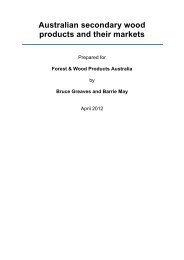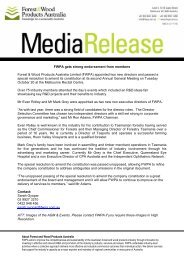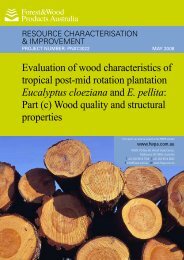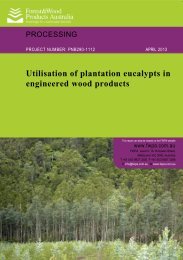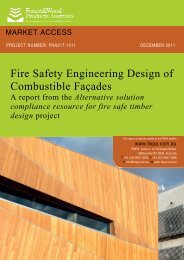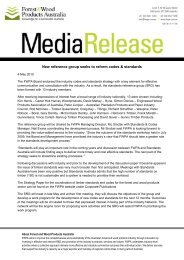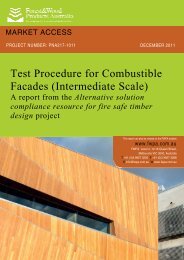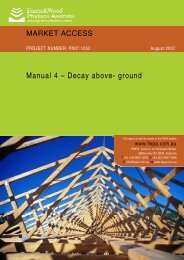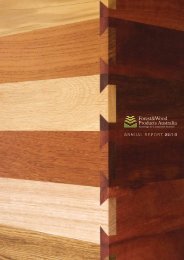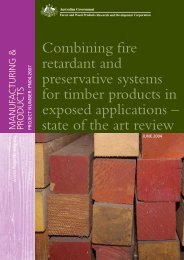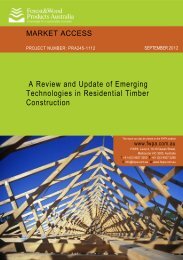Predicting the water-use of Eucalyptus nitens plantations in ...
Predicting the water-use of Eucalyptus nitens plantations in ...
Predicting the water-use of Eucalyptus nitens plantations in ...
Create successful ePaper yourself
Turn your PDF publications into a flip-book with our unique Google optimized e-Paper software.
It is important to note that <strong>the</strong> basal area: <strong>water</strong>-<strong>use</strong> function (Figure 4) has an upper limit<br />
determ<strong>in</strong>ed by potential evapotranspiration 1 (around 930 mm/yr), and a lower limit which<br />
represents <strong>the</strong> <strong>water</strong>-<strong>use</strong> <strong>of</strong> deforested land (around 500 mm/yr depend<strong>in</strong>g on weed/grass<br />
cover). It is likely that once <strong>the</strong> upper limit <strong>of</strong> <strong>water</strong>-<strong>use</strong> is achieved by a plantation, <strong>water</strong><strong>use</strong><br />
will cont<strong>in</strong>ue at this level while <strong>the</strong> plantation rema<strong>in</strong>s <strong>in</strong> good health.<br />
The potential evaporation estimate for <strong>the</strong> Florent<strong>in</strong>e Valley was obta<strong>in</strong>ed from Silo Data<br />
Drill and is calculated from air temperature, solar radiation and vapour pressure deficit data.<br />
Rayner (2006) concluded that <strong>the</strong> estimation method <strong>use</strong>d by Silo Data Drill tends to<br />
underestimate solar radiation dur<strong>in</strong>g w<strong>in</strong>dy conditions. It is likely that <strong>the</strong> annual potential<br />
evaporation estimate provided by Silo Data Drill is an underestimate for <strong>the</strong> site. This may<br />
expla<strong>in</strong> why it was possible for measured <strong>water</strong> <strong>use</strong> to exceed 1000 mm/yr <strong>in</strong> <strong>the</strong> oldest<br />
unth<strong>in</strong>ned plantation.<br />
Table 2. Summary <strong>of</strong> results for model fitt<strong>in</strong>g.<br />
Basal<br />
Area<br />
(m2/ha)<br />
Water<br />
Use<br />
Actual<br />
(mm/yr)<br />
Water Use<br />
Predicted<br />
(mm/yr)<br />
Water Use<br />
Residual<br />
(Actual-<br />
Predicted)<br />
Water<br />
Use Error<br />
(%) Year<br />
1.5 544.4 514.9 29.4 5.4 2008<br />
4.0 684.8 635.1 49.7 7.3 2009<br />
9.7 611.2 745.8 -134.7 22.0 2010<br />
8.3 746.0 725.8 20.2 2.7 2008<br />
13.2 909.1 784.5 124.5 13.7 2009<br />
18.7 753.3 828.0 -74.7 9.9 2010<br />
23.2 757.2 855.4 -98.2 13.0 2008<br />
32.2 1052.2 896.1 156.2 14.8 2008<br />
34.8 1022.2 906.1 116.1 11.4 2009<br />
37.3 864.4 914.5 -50.1 5.8 2010<br />
12.6 768.5 778.8 -10.3 1.3 2008<br />
14.5 779.8 796.4 -16.6 2.1 2009<br />
16.8 702.8 814.4 -111.6 15.9 2010<br />
Average Error<br />
1 Potential evapotranspiration (PET) is <strong>the</strong> loss expected over a surface with no limitation <strong>of</strong> <strong>water</strong>. It is a<br />
function <strong>of</strong> <strong>the</strong> atmospheric demand which depends primarily on <strong>the</strong> energy available from net radiation, <strong>the</strong><br />
humidity gradient <strong>in</strong> <strong>the</strong> lower atmosphere, w<strong>in</strong>d speed and surface roughness (Beven, 2005) or, is a<br />
representation <strong>of</strong> <strong>the</strong> environmental demand for evapotranspiration and represents <strong>the</strong> evapotranspiration rate <strong>of</strong><br />
a short green crop, completely shad<strong>in</strong>g <strong>the</strong> ground, <strong>of</strong> uniform height and with adequate <strong>water</strong> status <strong>in</strong> <strong>the</strong> soil<br />
pr<strong>of</strong>ile. It is a reflection <strong>of</strong> <strong>the</strong> energy available to evaporate <strong>water</strong>, and <strong>of</strong> <strong>the</strong> w<strong>in</strong>d available to transport <strong>the</strong><br />
<strong>water</strong> vapour from <strong>the</strong> ground up <strong>in</strong>to <strong>the</strong> lower atmosphere. Actual evapotranspiration is said to equal potential<br />
evapotranspiration when <strong>the</strong>re is ample <strong>water</strong> (Wikipedia - http://en.wikipedia.org/wiki/Evapotranspiration).<br />
9<br />
9.6



